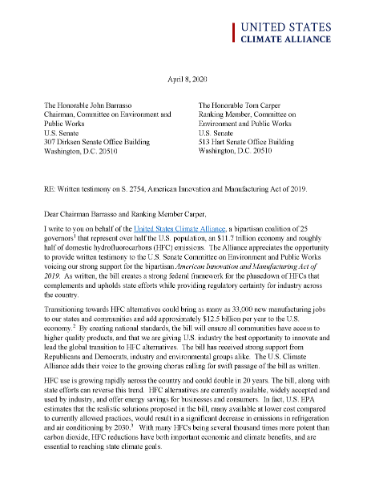Home / U.S. Climate Alliance Written Testimony on S. 2754, American Innovation and Manufacturing Act of 2019
- Letter
U.S. Climate Alliance Written Testimony on S. 2754, American Innovation and Manufacturing Act of 2019
April 8, 2020
RE: Written testimony on S. 2754, American Innovation and Manufacturing Act of 2019.
Dear Chairman Barrasso and Ranking Member Carper,
I write to you on behalf of the United States Climate Alliance, a bipartisan coalition of 25 governors1 that represent over half the U.S. population, an $11.7 trillion economy and roughly half of domestic hydrofluorocarbons (HFC) emissions. The Alliance appreciates the opportunity to provide written testimony to the U.S. Senate Committee on Environment and Public Works voicing our strong support for the bipartisan American Innovation and Manufacturing Act of 2019. As written, the bill creates a strong federal framework for the phasedown of HFCs that complements and upholds state efforts while providing regulatory certainty for industry across the country.
Transitioning towards HFC alternatives could bring as many as 33,000 new manufacturing jobs to our states and communities and add approximately $12.5 billion per year to the U.S. economy.2 By creating national standards, the bill will ensure all communities have access to higher quality products, and that we are giving U.S. industry the best opportunity to innovate and lead the global transition to HFC alternatives. The bill has received strong support from Republicans and Democrats, industry and environmental groups alike. The U.S. Climate Alliance adds their voice to the growing chorus calling for swift passage of the bill as written.
HFC use is growing rapidly across the country and could double in 20 years. The bill, along with state efforts can reverse this trend. HFC alternatives are currently available, widely accepted and used by industry, and offer energy savings for businesses and consumers. In fact, U.S. EPA estimates that the realistic solutions proposed in the bill, many available at lower cost compared to currently allowed practices, would result in a significant decrease in emissions in refrigeration and air conditioning by 2030.3 With many HFCs being several thousand times more potent than carbon dioxide, HFC reductions have both important economic and climate benefits, and are essential to reaching state climate goals.
Effectively designed measures to phase-down HFCs will also increase U.S. businesses and states’ competitiveness globally. Under the Kigali Amendment to the Montreal Protocol, the rest of the world has agreed to transition away from HFCs. The European Union has already adopted regulations to phase down HFCs, with more countries to come. Despite this, the U.S. federal government has yet to act, decreasing the global competitiveness of our companies and their products. This bill alone is estimated to increase the global share of the U.S. alternative fluorocarbon product and equipment market by 25 percent.
At a time when a global pandemic has brought hardship, this bill could drive innovation and create jobs, contributing to the economic growth the nation needs. By supporting and promoting the manufacture of next-generation technologies, the bill will help put American companies on a level playing field with their global competitors by proactively phasing down these harmful substances.
The U.S. Climate Alliance supports the American Innovation and Manufacturing Act of 2019 as it is currently written and strongly encourages congress to pass this bill as drafted, and work with states on swift and effective implementation.
Respectfully,
Julie Cerqueira
Executive Director, U.S. Climate Alliance
About the Alliance
Launched in 2017 by the governors of Washington, New York, and California to help fill the void left by the U.S. federal government’s withdrawal from the Paris Agreement, the Alliance has grown to include 24 governors from across the U.S. representing approximately 60 percent of the U.S. economy and 55 percent of the U.S. population. Governors in the Alliance have pledged to collectively reduce net greenhouse gas emissions by at least 26-28 percent by 2025, 50-52 percent by 2030, and 61-66 percent by 2035, all below 2005 levels, and collectively achieve overall net-zero greenhouse gas emissions as soon as practicable, and no later than 2050.
The Alliance’s states and territories continue to advance innovative and impactful climate solutions to grow the economy, create jobs, and protect public health, and have a long record of action and results. In fact, the latest data shows that as of 2023, the Alliance has reduced its collective net greenhouse gas emissions by 24 percent below 2005 levels, while increasing collective GDP by 34 percent, and is on track to meet its near-term climate goal of reducing collective greenhouse gas emissions 26 percent below 2005 levels by 2025.
###
